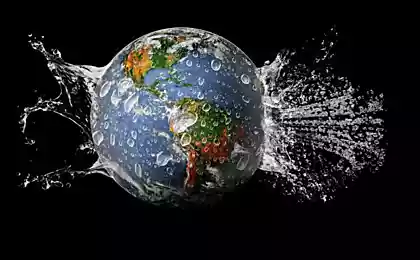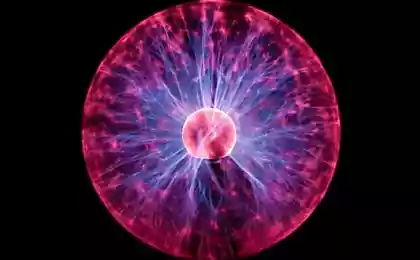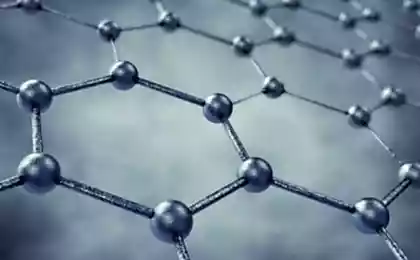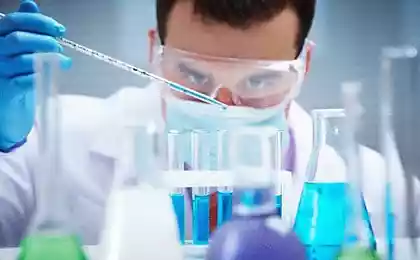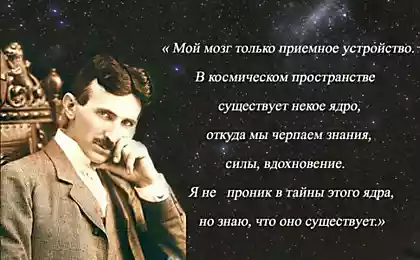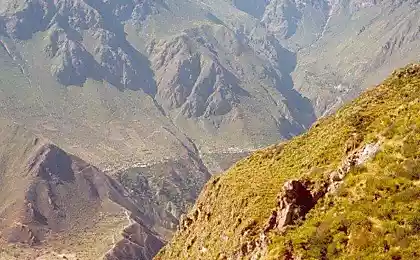1297
10 essential for life on Earth events under the microscope
What determines our life? The earth is very old and very big, but for billions of years, it has accumulated a lot of microscopic details. Modern technology can give us amazing views of the tiny things that remained after the major human and natural events in the past and exist today.
1. Freeze the formation of the solar sistemy
It is a thin slice of the meteorite, which is over the age of 4, 5 billion years. Because of the round spots, called chondrules, meteorites called chondrites these. Today chondrites show scientists how the Earth formed and the rest of the solar system.
They appeared when the solar system was only a cloud of interstellar dust, which is part of the alloy in chondrites. The rest part of it began to gather in more and larger objects with increasing gravity. It was a continuous process that ended only when the center of the cloud came a glowing object like a star - our sun.
What remained of the dust and chondrites, it became the planets, moons, asteroids and comets. After that, all the planets and many moons become large enough to continue independent development.
Asteroids and some other facilities were too small for further development and just stayed in the solar system billions of years, sometimes breaking and arrival to Earth. Today, scientists know that the bright chondrites are part of the cloud of interstellar dust from which the solar system emerged.
2. Possible components of life in kosmose
This vague blurred image - real equivalent of the chemical formulas, which you saw in their textbooks. The image was obtained using a tool called "non-contact atomic force microscope».
It shows the carbon and hydrogen atoms bonded together in three benzene rings. Astrobiologists like hexagonal structure of the benzene ring because of it can be formed by different types of molecules that can be found in outer space, including polycyclic aromatic hydrocarbons (PAHs).
These and other carbon-based organic molecules account for about half of the dust and gas clouds, floating between the stars.
Studying PAH, scientists have made a startling discovery. In the laboratory, they have created for the pyrimidine material similar to PAHs environment that simulates the harsh conditions of space. The experiment formed uracil, cytosine and thymine - three materials found in the genetic material of all life on Earth.
Someday scientists know exactly how life began on Earth. And today we can say with confidence: since the origin of life there were many disappearances. And perhaps worst of all caused little creatures called ...
3. Cyanobacteria: cell, which gave the world kislorod
In this picture it is exactly what you're thinking: the accumulation of bacterial cells under a microscope. Previously, these creatures were known as blue-green algae, but today they are called "cyanobacteria».
The first surprising fact about them - they are a billion years. The scientists dug them and 29 other species of bacteria from the geological formations of Australia, whose age is a billion years old.
As the bacteria are in the fossil record? Cyanobacteria are larger than most of the other bacteria, and have thick cell walls. They live in the coatings, forming layered structures - stromatolites and oncolites. In the separation of ancient stromatolites on very thin plates sometimes can be found fossilized cyanobacteria.
Even more surprising fact is that without cyanobacteria life on Earth as we know it today, would never have existed. In his "youth" Earth's atmosphere was similar to the smoky air of Titan, Saturn's moon. He was toxic to modern forms of life, but some microorganisms, including cyanobacteria, were able to cope with it.
Then, about 2, 3 billion years ago, cyanobacteria developed the ability to live off sunlight through photosynthesis. One side effect of photosynthesis is oxygen, which proved fatal to the microbes, preferring could.
Since cyanobacteria was extremely much oxygen catastrophe changed the atmosphere of the planet and probably caused the greatest mass extinction on Earth. However, it also laid the groundwork for modern plants and animals.
That cyanobacteria killed other beings, breathe smog, only guesses. But we know that there was another event called "the great extinction", after which almost all life on Earth disappeared. One reason for this mass extinction was ...
4. Siberian trappy
So geologists call a very thin slice of rock. If you look at it under a microscope using polarized light, you can determine the color of different minerals.
The figure shows a thin slice of leucocratic gabbro. The white part of the image - is a mineral plagioclase, and blue - amphibole. Notice how all of the minerals are joined together; It seems that they are bogged down in a stream of black material, the current sluggish in this photo from left to right, like a Hawaiian lava.
Once upon a time, about 250 million years ago, this stuff is really overflowed like lava, vybivshis out of the ground in what is now Siberia. Flooding Siberian traps occurred during the Permian period about the same time the largest known mass extinction of life on Earth.
Flood basalts lasted one million years. Lava was so much that it would be enough to bury a Europe kilometer layer.
Of course, this has a negative impact on life on Earth. During the great extinction, a host of destructive factors soot and ash from the eruption blocked sunlight and lava burst of poisonous gases, toxic air and water. During this period the world has disappeared approximately 93-97% of all life.
Some believe that the flood was caused by magma emissions; others associate it with plate tectonics. Siberian lava silent, not wanting to reveal his secret.
Earth passes cycles of life and death. Some of them are imprinted in its rocks, but the atmosphere does not keep records. Or? ..
5. The Earth's atmosphere 420,000 years nazad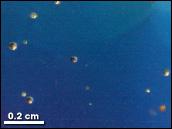
These tiny bubbles will not appear in the water. They froze in the ice hundreds of thousands of years ago. The analysis contained in the air which tell a lot about the ancient climate, scientists of the Earth, how it has changed over time and how it can change in the future.
So, as the air hit the ice and how it was possible to determine its age? Falling to the ground, snow crystals trap air. When the snow melts, it turns into glacial ice with air bubbles inside.
Sometimes glaciers move horizontally, but vertically not change their position. Because of this, scientists have no radiocarbon dating can determine the age of the horizontal layers of ice - younger layers are always on top.
That is what determined that the air bubbles found in the ice of Antarctica and Greenland, contain air, which is as much as 420,000 years.
Changes in the amount of carbon dioxide in the air, of course, can affect the climate. Today it is a big problem, but fortunately, there is a small sea creatures that help us cope with it.
6. Chief processor ugleroda
This is not a satellite image of the forest with the envelope of his way. This kind of microscope to Alteromonas, newly discovered bacteria, which play an important role in the control of carbon dioxide (CO2).
The carbon in the world is everywhere. It is present both in the air and in the oceans of the world. Seawater absorbs and releases the carbon dioxide in the atmosphere.
Plankton is fed with carbon. After the death of the body of plankton sink to the bottom of the ocean where they feed on bacteria. The bacteria were then release carbon dioxide, which is eventually returned to the atmosphere.
At least, the scientists think that everything is just so. A large part of the process takes place deep in the ocean, and there are scientists, unfortunately, watching him can not.
7. Plants that nine million let
Plants help keep the atmosphere breathable. The parts shown in the photo, it is a plant, petrified in a moment during the fall of a meteorite millions of years ago.
Scientists have no idea how organic matter could withstand so much heat. Thanks to this discovery, we now know that life on Mars, if it ever was there, would remain that way.
Here's what happened: around nine million years ago on the territory of modern Argentina fell seven different cosmic objects. The land in the area was covered with powdery soil called loess under which melts and quickly turned into a glass.
Scientists have conducted a series of experiments and after many failures have found that at temperatures above 1480 degrees Celsius in water the outer layers of the plant absorbs enough heat to protect the delicate internal structure. Something similar happens when you fry food in oil.
Mars, too, is covered by loess and has many craters. Already billions of years on the red planet no lakes or rivers. But maybe, once they were there. There could be a life, and it is likely that the fall of the meteorite as it would protect the Loess glass, as in the case of plants in the world.
8. Freeze largest recent eruptions vulkanov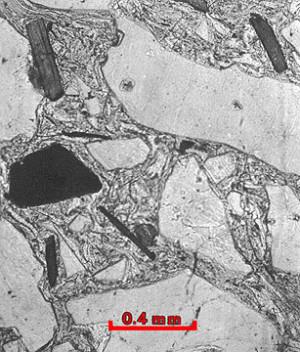
This image is similar to the much larger picture of Van Gogh's "Starry Night," but in fact it is another thin slice of geological volcanic rock. But unlike the previous one there are a lot of sharp corners. It was a powerful eruption, not sluggish Hawaiian lava.
Large pieces - is broken fragments of minerals. They stood in the molten rock. Look closely and you will see the dark emptiness that stretched like a melted candy.
This is a small part of superizverzheniya Toba volcano, which occurred about 75 000 years ago. It was the biggest eruption in recorded history, while it resulted in 2900 cubic kilometers of magma and were released into the sky three trillion kilograms of sulfur.
When the explosion occurred, mineral crystals are split into fragments. A few seconds later they were in the hot gassy volcanic ash. The gas quickly dissipated, leaving gaps in the ash particles, which appear black polarized light.
Tens of thousands of years later, geologists studying these fragments still amazed cruelty Toba. Ash from the eruption scattered over East Africa at 7000 km.
9. People have tamed ogon
That's exactly what it looks like. Brownish substance - it's dirt, lighter particles - ashes left over from wood and charcoal - partially burned remains of plants.
Surprisingly, this is proof that people have conquered the fire a million years ago - far earlier than ever thought. Estimates of the exact date of domestication of fire has always been inaccurate. It is difficult to say whether the ancient layers of ash remains of a forest fire, or they were in the process of cooking.
A few years ago, scientists have tested the ashes of the most advanced technology. Ash took from the hearth, extinct about one million years ago and is found in South African cave. He was untouched, perfectly preserved and could be caused by natural phenomena, because not far from it were found stone tools.
What we see here - ashen remains of plants that someone, perhaps it was Homo erectus, brought into the cave million years ago. And, most likely, he was not a vegetarian, as close to the charred bones were found.
Control of the fire was our biggest step toward becoming the masters of the earth, that we are today. But do we really home? Scientists are beginning to realize that the largest mass of living organisms on Earth may actually hiding in the rocky crust beneath the oceans. These creatures are called ...
10. Endolity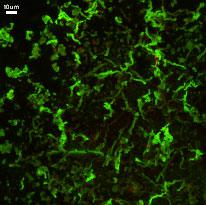
The easiest way to allow scientists say that these little "twisted stems of mineral extracted in the course of experiments on the incubation of minerals from wells Strait of Juan de Fuca," produced by oxidizing iron bacteria.
Keyword - "Well." Scientists have carefully studied the ocean floor and found bacteria living there. These small creatures that live in the rocks, called "endolithic" lived there before. They live in the stone, and eat it. Scientists have long known about them, but only recently became aware that endolithic in the world can be so many that it is impossible to imagine.
Most of the Earth's oceanic crust is covered. The bottom of the ocean is made up of basaltic lava, which erupted in mid-ocean ridges, and then moves away from the ridges on the peculiar geological conveyor belt.
There's plenty of water and heat - two things necessary for life on Earth. In addition, aquatic life is already flourishing at mid-ocean ridges in hydrothermal vents. So why not prosper within the seabed?
Now imagine that all of the oceanic crust is inhabited by living creatures. Scientists believe that the seabed biomass may be greater than on land and in the sea together!
via listverse.com/2015/04/12/10-microscopic-views-of-events-with-huge-consequences-for-earth/
1. Freeze the formation of the solar sistemy

It is a thin slice of the meteorite, which is over the age of 4, 5 billion years. Because of the round spots, called chondrules, meteorites called chondrites these. Today chondrites show scientists how the Earth formed and the rest of the solar system.
They appeared when the solar system was only a cloud of interstellar dust, which is part of the alloy in chondrites. The rest part of it began to gather in more and larger objects with increasing gravity. It was a continuous process that ended only when the center of the cloud came a glowing object like a star - our sun.
What remained of the dust and chondrites, it became the planets, moons, asteroids and comets. After that, all the planets and many moons become large enough to continue independent development.
Asteroids and some other facilities were too small for further development and just stayed in the solar system billions of years, sometimes breaking and arrival to Earth. Today, scientists know that the bright chondrites are part of the cloud of interstellar dust from which the solar system emerged.
2. Possible components of life in kosmose

This vague blurred image - real equivalent of the chemical formulas, which you saw in their textbooks. The image was obtained using a tool called "non-contact atomic force microscope».
It shows the carbon and hydrogen atoms bonded together in three benzene rings. Astrobiologists like hexagonal structure of the benzene ring because of it can be formed by different types of molecules that can be found in outer space, including polycyclic aromatic hydrocarbons (PAHs).
These and other carbon-based organic molecules account for about half of the dust and gas clouds, floating between the stars.
Studying PAH, scientists have made a startling discovery. In the laboratory, they have created for the pyrimidine material similar to PAHs environment that simulates the harsh conditions of space. The experiment formed uracil, cytosine and thymine - three materials found in the genetic material of all life on Earth.
Someday scientists know exactly how life began on Earth. And today we can say with confidence: since the origin of life there were many disappearances. And perhaps worst of all caused little creatures called ...
3. Cyanobacteria: cell, which gave the world kislorod

In this picture it is exactly what you're thinking: the accumulation of bacterial cells under a microscope. Previously, these creatures were known as blue-green algae, but today they are called "cyanobacteria».
The first surprising fact about them - they are a billion years. The scientists dug them and 29 other species of bacteria from the geological formations of Australia, whose age is a billion years old.
As the bacteria are in the fossil record? Cyanobacteria are larger than most of the other bacteria, and have thick cell walls. They live in the coatings, forming layered structures - stromatolites and oncolites. In the separation of ancient stromatolites on very thin plates sometimes can be found fossilized cyanobacteria.
Even more surprising fact is that without cyanobacteria life on Earth as we know it today, would never have existed. In his "youth" Earth's atmosphere was similar to the smoky air of Titan, Saturn's moon. He was toxic to modern forms of life, but some microorganisms, including cyanobacteria, were able to cope with it.
Then, about 2, 3 billion years ago, cyanobacteria developed the ability to live off sunlight through photosynthesis. One side effect of photosynthesis is oxygen, which proved fatal to the microbes, preferring could.
Since cyanobacteria was extremely much oxygen catastrophe changed the atmosphere of the planet and probably caused the greatest mass extinction on Earth. However, it also laid the groundwork for modern plants and animals.
That cyanobacteria killed other beings, breathe smog, only guesses. But we know that there was another event called "the great extinction", after which almost all life on Earth disappeared. One reason for this mass extinction was ...
4. Siberian trappy

So geologists call a very thin slice of rock. If you look at it under a microscope using polarized light, you can determine the color of different minerals.
The figure shows a thin slice of leucocratic gabbro. The white part of the image - is a mineral plagioclase, and blue - amphibole. Notice how all of the minerals are joined together; It seems that they are bogged down in a stream of black material, the current sluggish in this photo from left to right, like a Hawaiian lava.
Once upon a time, about 250 million years ago, this stuff is really overflowed like lava, vybivshis out of the ground in what is now Siberia. Flooding Siberian traps occurred during the Permian period about the same time the largest known mass extinction of life on Earth.
Flood basalts lasted one million years. Lava was so much that it would be enough to bury a Europe kilometer layer.
Of course, this has a negative impact on life on Earth. During the great extinction, a host of destructive factors soot and ash from the eruption blocked sunlight and lava burst of poisonous gases, toxic air and water. During this period the world has disappeared approximately 93-97% of all life.
Some believe that the flood was caused by magma emissions; others associate it with plate tectonics. Siberian lava silent, not wanting to reveal his secret.
Earth passes cycles of life and death. Some of them are imprinted in its rocks, but the atmosphere does not keep records. Or? ..
5. The Earth's atmosphere 420,000 years nazad

These tiny bubbles will not appear in the water. They froze in the ice hundreds of thousands of years ago. The analysis contained in the air which tell a lot about the ancient climate, scientists of the Earth, how it has changed over time and how it can change in the future.
So, as the air hit the ice and how it was possible to determine its age? Falling to the ground, snow crystals trap air. When the snow melts, it turns into glacial ice with air bubbles inside.
Sometimes glaciers move horizontally, but vertically not change their position. Because of this, scientists have no radiocarbon dating can determine the age of the horizontal layers of ice - younger layers are always on top.
That is what determined that the air bubbles found in the ice of Antarctica and Greenland, contain air, which is as much as 420,000 years.
Changes in the amount of carbon dioxide in the air, of course, can affect the climate. Today it is a big problem, but fortunately, there is a small sea creatures that help us cope with it.
6. Chief processor ugleroda

This is not a satellite image of the forest with the envelope of his way. This kind of microscope to Alteromonas, newly discovered bacteria, which play an important role in the control of carbon dioxide (CO2).
The carbon in the world is everywhere. It is present both in the air and in the oceans of the world. Seawater absorbs and releases the carbon dioxide in the atmosphere.
Plankton is fed with carbon. After the death of the body of plankton sink to the bottom of the ocean where they feed on bacteria. The bacteria were then release carbon dioxide, which is eventually returned to the atmosphere.
At least, the scientists think that everything is just so. A large part of the process takes place deep in the ocean, and there are scientists, unfortunately, watching him can not.
7. Plants that nine million let

Plants help keep the atmosphere breathable. The parts shown in the photo, it is a plant, petrified in a moment during the fall of a meteorite millions of years ago.
Scientists have no idea how organic matter could withstand so much heat. Thanks to this discovery, we now know that life on Mars, if it ever was there, would remain that way.
Here's what happened: around nine million years ago on the territory of modern Argentina fell seven different cosmic objects. The land in the area was covered with powdery soil called loess under which melts and quickly turned into a glass.
Scientists have conducted a series of experiments and after many failures have found that at temperatures above 1480 degrees Celsius in water the outer layers of the plant absorbs enough heat to protect the delicate internal structure. Something similar happens when you fry food in oil.
Mars, too, is covered by loess and has many craters. Already billions of years on the red planet no lakes or rivers. But maybe, once they were there. There could be a life, and it is likely that the fall of the meteorite as it would protect the Loess glass, as in the case of plants in the world.
8. Freeze largest recent eruptions vulkanov

This image is similar to the much larger picture of Van Gogh's "Starry Night," but in fact it is another thin slice of geological volcanic rock. But unlike the previous one there are a lot of sharp corners. It was a powerful eruption, not sluggish Hawaiian lava.
Large pieces - is broken fragments of minerals. They stood in the molten rock. Look closely and you will see the dark emptiness that stretched like a melted candy.
This is a small part of superizverzheniya Toba volcano, which occurred about 75 000 years ago. It was the biggest eruption in recorded history, while it resulted in 2900 cubic kilometers of magma and were released into the sky three trillion kilograms of sulfur.
When the explosion occurred, mineral crystals are split into fragments. A few seconds later they were in the hot gassy volcanic ash. The gas quickly dissipated, leaving gaps in the ash particles, which appear black polarized light.
Tens of thousands of years later, geologists studying these fragments still amazed cruelty Toba. Ash from the eruption scattered over East Africa at 7000 km.
9. People have tamed ogon

That's exactly what it looks like. Brownish substance - it's dirt, lighter particles - ashes left over from wood and charcoal - partially burned remains of plants.
Surprisingly, this is proof that people have conquered the fire a million years ago - far earlier than ever thought. Estimates of the exact date of domestication of fire has always been inaccurate. It is difficult to say whether the ancient layers of ash remains of a forest fire, or they were in the process of cooking.
A few years ago, scientists have tested the ashes of the most advanced technology. Ash took from the hearth, extinct about one million years ago and is found in South African cave. He was untouched, perfectly preserved and could be caused by natural phenomena, because not far from it were found stone tools.
What we see here - ashen remains of plants that someone, perhaps it was Homo erectus, brought into the cave million years ago. And, most likely, he was not a vegetarian, as close to the charred bones were found.
Control of the fire was our biggest step toward becoming the masters of the earth, that we are today. But do we really home? Scientists are beginning to realize that the largest mass of living organisms on Earth may actually hiding in the rocky crust beneath the oceans. These creatures are called ...
10. Endolity

The easiest way to allow scientists say that these little "twisted stems of mineral extracted in the course of experiments on the incubation of minerals from wells Strait of Juan de Fuca," produced by oxidizing iron bacteria.
Keyword - "Well." Scientists have carefully studied the ocean floor and found bacteria living there. These small creatures that live in the rocks, called "endolithic" lived there before. They live in the stone, and eat it. Scientists have long known about them, but only recently became aware that endolithic in the world can be so many that it is impossible to imagine.
Most of the Earth's oceanic crust is covered. The bottom of the ocean is made up of basaltic lava, which erupted in mid-ocean ridges, and then moves away from the ridges on the peculiar geological conveyor belt.
There's plenty of water and heat - two things necessary for life on Earth. In addition, aquatic life is already flourishing at mid-ocean ridges in hydrothermal vents. So why not prosper within the seabed?
Now imagine that all of the oceanic crust is inhabited by living creatures. Scientists believe that the seabed biomass may be greater than on land and in the sea together!
via listverse.com/2015/04/12/10-microscopic-views-of-events-with-huge-consequences-for-earth/
"The new middle": in the modern world 60 years - not retirement
As cats communicate with us via meow, blinking and mustache
